|
ILEIA was founded around 20 years ago initially to address concerns with the sustainability of green revolution technologies. It has investigated a wide range of options – such as indigenous, organic and permaculture technologies, working mainly with committed practitioners concerned to optimise local resource use. There have been some major successes (for example the organic movement in the North, a variety of smaller success in the South) but these have tended to be scattered and not coherent. The emphasis is on Low External Input Sustainable Agriculture (LEISA). This involves working within natural constraints, adapting to specific sites, feeding soils and recycling in many ways, emphasising micro-climate management, synergy and complementarity, and minimal fossil fuel use.
ILEIA has found that LEISA is feasible and viable, that small farms are more productive than larger farms, and that small farmers are willing to invest – but they need support. Support is needed to enhance their secure access to and control of resources (especially land). Institutions are needed to defend their rights. They also need access to information on strategies and specific technologies. Wider policy support is also crucial. Finally, development involves change on a number of local and wider fronts, and farmers need support in coping with and managing transitions.
Discussion:
A variety of questions were raised in discussion.
Harnessing private sector research: how can this be done more effectively, and are there examples of private sector research in LEISA?
Michael Lipton suggested that more effective harnessing of private sector research required very careful and precise contracts specifying required outputs – and that these needed to be achievable to provide private sector research organizations with profit incentives – but that other incentives to private sector investment can also be important (such as their need to attract top quality researchers and allow them some flexibility to work on interesting and socially important issues). He suggested that organic farming might be a LEISA area which private sector research might have a role. Anita Ingevall stressed the difficulties that common property rights posed for private research investment.
What are the implications of long term challenges of climate change and fossil fuel depletion?
Anita Ingevall pointed out the very inefficient use of fossil fuels in many intensive production systems, and also in food distribution systems. There is a need to adapt to fossil fuel shortages by sourcing local produce. Michael Lipton commented that high energy and transport costs will hit low value products hardest (although transport costs have been falling). This question also meant that in some circumstances investments in roads in Africa needs to be questioned – although there is a serious need for better roads in Africa in some areas it is important to ask what supply and demand the roads will serve.
What should be done about large areas of marginal land being cropped unsustainably (for example in some areas of Southern Africa)?
Michael Lipton commented that there is a need to intensify with better water control and use of inorganic fertilizer where it can be done in sustainable ways with economic benefit – subsidies to intensification in other circumstances are damaging. In some areas of West Africa there are very low returns to fertilizer without higher levels of organic matter in the soil – there is then a need to identify farmer incentives for undertaking costly investments in applying organic matter to the soil – this needs better farmer access to water control, crop germplasm and inorganic fertilizers so that organic matter investments can yield returns to farmers.
Can LEISA benefit from transgenic technologies (for example Bt maize has encouraged conservation tillage and ox-ploughing with reduced tractor ploughing in parts of KwaZulu-Natal in South Africa)?
Anita Ingevall responded by noting that some LEIA technologies, such as conservation tillage, have been part of mainstream commercial agriculture – but that these could be pursued without GM. Michael Lipton argued that there was potential for strong complementarity between GM techniques and LEISA – as argued, for example, by Professor Swaminathan, a leading figure in the Asian green revolution.
Is it practical for international research centres to concentrate more on generic yield enhancement issues and to leave more locally specific NRM management and social issues to national research systems when national research systems are often weak?
Michael Lipton agreed that NARS are often weak, because African governments are so stretched as regards public expenditure constraints – and this means that donor investments in this area often allow reductions in governments’ own expenditure commitments. There are also very substantial incentive and system problems that prevent highly able and committed staff in NARS from being effective. These systemic problems need to be addressed – capacity building by itself is not enough. Nevertheless there are some very effective NARS in Africa (for example in Kenya)
Can small farmers make more use of the stock of technologies that have already been developed for large, corporate farming?
Both speakers agreed that although there is some potential for this there are also fundamental differences in technology needs between small and large farms, and this limits the extent to which ‘on the shelf’ technologies for large farms can be adapted to the benefit of small farms. A big advantage of seed and fertilizer technologies is that they are generally divisible (apart from transaction costs of accessing them): this is not the case with many other (for example machinery) technologies.
Can the high costs of obtaining expert knowledge on LEISA be reduced?
The speakers agreed that this is a major challenge. Anita reported that much more information is now available than it was – but it can be difficult to track down and apply.
Can international research centres deliver demand driven research to small farmers or are they too remote, and how can the more locally specific science demands for LEISA be met?
Michael Lipton suggested that paradoxically the international research system had been more effective in promoting participatory research approaches than national and local research systems. Anita Ingevall questioned this. She noted that the development of locally specific technologies required the development of wider strategic solutions and principles.
How quickly could transgenics science come up with solutions to the water challenges posed by Michael?
Michael Lipton agreed that this is a major challenge – very substantial resources will be needed over a long period. He suggested as a very rough estimate that a period of 15 years or so could deliver substantial progress if the whole CG system budget (£300 million per year) were devoted to it. Anita Ingevall suggested that this will never happen, the challenge is too great: plants cannot be pushed to increase their output on two major fronts (moisture stress resistance and high yields). Michael Lipton commented that the long history of plant breeding suggested that net gains in plant performance are possible.
Conclusion
The chair noted the agreement between the speakers on the major challenges to agriculture and poverty reduction and the importance of technology to this, agreement on some responses but differences over others. He thanked the speakers for their informative and stimulating presentations and discussion.
|

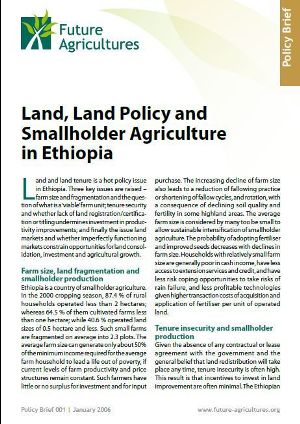 Land and land tenure is a hot policy issue in Ethiopia. Three key issues are raised – farm size and fragmentation and the question of what is a ‘viable’ farm unit; tenure security and whether lack of land registration/certi. Cation or titling undermines investment in productivity improvements; and finally the issue land markets andwhether imperfectly functioning markets constrain opportunities for land consolidation, investment and agricultural growth.
Land and land tenure is a hot policy issue in Ethiopia. Three key issues are raised – farm size and fragmentation and the question of what is a ‘viable’ farm unit; tenure security and whether lack of land registration/certi. Cation or titling undermines investment in productivity improvements; and finally the issue land markets andwhether imperfectly functioning markets constrain opportunities for land consolidation, investment and agricultural growth.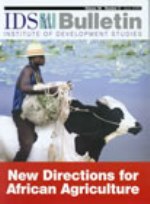 This IDS Bulletin draws together contributions from a diverse range of researchers and development practitioners working in Africa, with the common goal of exploring why agriculture is contributing to poverty reduction and livelihood improvement in some places. This debate comes at a critical time when there is renewed interest in agriculture in Africa and a real commitment to revitalise the sector. How to translate words into reality? How to avoid the recycling of old ideas, and generate new thinking – rooted in African contexts and ground realities – which makes a difference? Central to all solutions are social, cultural and political factors: rather than an expert-driven, technocratic approach, a more politically-sophisticated stance is required with a new emphasis on understanding and influencing processes of innovation, intervention and policy. The aim of this IDS Bulletin is to contribute to this journey.
This IDS Bulletin draws together contributions from a diverse range of researchers and development practitioners working in Africa, with the common goal of exploring why agriculture is contributing to poverty reduction and livelihood improvement in some places. This debate comes at a critical time when there is renewed interest in agriculture in Africa and a real commitment to revitalise the sector. How to translate words into reality? How to avoid the recycling of old ideas, and generate new thinking – rooted in African contexts and ground realities – which makes a difference? Central to all solutions are social, cultural and political factors: rather than an expert-driven, technocratic approach, a more politically-sophisticated stance is required with a new emphasis on understanding and influencing processes of innovation, intervention and policy. The aim of this IDS Bulletin is to contribute to this journey.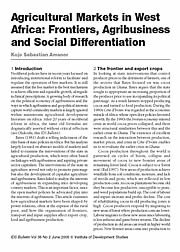 Neoliberal policies have in recent years focused on introducing institutional reform to facilitate and regulate the operation of free markets. It is still assumed that the freemarket is the best mechanism to achieve efficient and equitable growth, alongsidetechnical prescriptions. A growing body of research on the political economy of agribusiness and the ways in which agribusiness and geopolitical interestscapture world commodity markets is largely ignored within mainstream agricultural development literature on Africa. After 20 years of neoliberal reform in Africa, the same old formulas are dogmatically asserted without critical reflection.
Neoliberal policies have in recent years focused on introducing institutional reform to facilitate and regulate the operation of free markets. It is still assumed that the freemarket is the best mechanism to achieve efficient and equitable growth, alongsidetechnical prescriptions. A growing body of research on the political economy of agribusiness and the ways in which agribusiness and geopolitical interestscapture world commodity markets is largely ignored within mainstream agricultural development literature on Africa. After 20 years of neoliberal reform in Africa, the same old formulas are dogmatically asserted without critical reflection.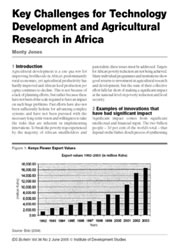 Agricultural development is a sine qua non fo improving livelihoods in Africa’s predominantlyrural economies, yet agricultural productivity has hardly improved and African food production percapita continues to decline. This is not because of a lack of planning efforts, but rather because thesehave not been of the scale required to have an impact on such huge problems. Past efforts have also no been sufficiently holistic for advancing comple systems and have not been pursued with thenecessary long-term vision and willingness to take the risks that are inherent in implementinginnovations.
Agricultural development is a sine qua non fo improving livelihoods in Africa’s predominantlyrural economies, yet agricultural productivity has hardly improved and African food production percapita continues to decline. This is not because of a lack of planning efforts, but rather because thesehave not been of the scale required to have an impact on such huge problems. Past efforts have also no been sufficiently holistic for advancing comple systems and have not been pursued with thenecessary long-term vision and willingness to take the risks that are inherent in implementinginnovations.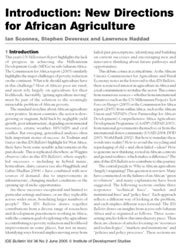 This year’s UNMillennium Report highlights the lack of progress in achieving the Millennium Development Goals (MDGs) in sub-Saharan Africa. The Commission for Africa report (2005) similarly highlights themajor challenges of poverty reduction on the continent.What role should agriculture have in this challenge? Most of Africa’s poor are rural, and most rely largely on agriculture for their livelihoods. Inevitably, “getting agriculture moving” must be part of the solution to the seemingly intractable problem of African poverty.
This year’s UNMillennium Report highlights the lack of progress in achieving the Millennium Development Goals (MDGs) in sub-Saharan Africa. The Commission for Africa report (2005) similarly highlights themajor challenges of poverty reduction on the continent.What role should agriculture have in this challenge? Most of Africa’s poor are rural, and most rely largely on agriculture for their livelihoods. Inevitably, “getting agriculture moving” must be part of the solution to the seemingly intractable problem of African poverty. Links to selected articles to download:
Links to selected articles to download: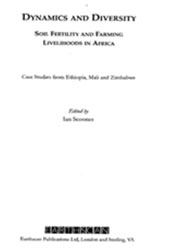 Local classification of soil types,
Local classification of soil types,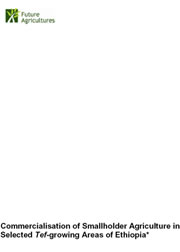 {jcomments off}The poverty-reduction strategy adopted by Ethiopia seeks to achieve growth through the commercialisation of smallholder agriculture. The Plan for Accelerated and Sustainable Development to End Poverty (PASDEP), Ethiopia.s strategic framework for 2005/06 – 2009/10, relies on a massive push to accelerate growth. This is to be achieved by efforts in two directions: commercialisation of agriculture, based on supporting the intensification of marketable farm products (both for domestic and export markets, and by both small and large farmers); and promoting much more rapid non-farm private sector growth (MoFED, 2005).
{jcomments off}The poverty-reduction strategy adopted by Ethiopia seeks to achieve growth through the commercialisation of smallholder agriculture. The Plan for Accelerated and Sustainable Development to End Poverty (PASDEP), Ethiopia.s strategic framework for 2005/06 – 2009/10, relies on a massive push to accelerate growth. This is to be achieved by efforts in two directions: commercialisation of agriculture, based on supporting the intensification of marketable farm products (both for domestic and export markets, and by both small and large farmers); and promoting much more rapid non-farm private sector growth (MoFED, 2005). Part 1: Theoretical reflections on knowledge, power and practice
Part 1: Theoretical reflections on knowledge, power and practice